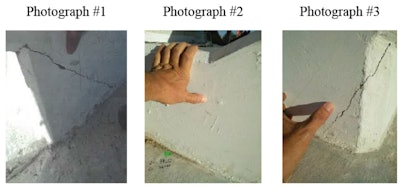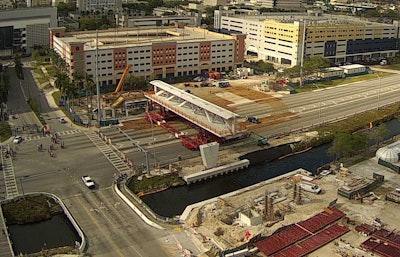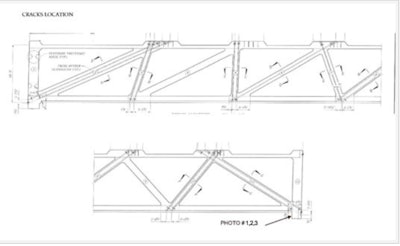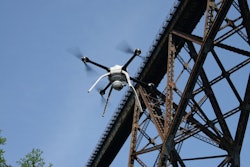
Well before a deadly bridge collapse on March 15, a series of cracks had begun emerging on both the south and north ends of the new pedestrian bridge at Florida International University in Miami, the National Transit Safety Board says in a new preliminary report.
It says that cracks on the bridge’s north end were documented with photos a full 19 days before the failure that killed six people.
The significance of the cracking remains unclear. The investigation into the cause of the collapse of the 950-ton bridge could continue into 2019. The cracking has been a concern from the start, though the preliminary report shows the cracks had actually been noticed much earlier than had first been made public.
Two days before the bridge fell, the lead engineer on the project had left a voicemail with state officials saying cracking had been seen on the north end of the span that had been earlier moved into place during accelerated construction.
The engineer, W. Denney Pate with FIGG Bridge Engineers, had said that the crack was not a safety concern, according to a recording and transcript of the call released by the Florida Department of Transportation (FDOT). Safety issues had also been allayed during a meeting about the crack with the bridge design team and FDOT at the construction site just a few hours before the collapse, officials have said.
The NTSB continues to investigate the cracking as well as evaluate the bridge design, the construction process and the construction materials, the agency explains in the preliminary report released six days ago.
To read the full preliminary report, click here.
In the coming weeks, the NTSB says, it will be conducting additional forensic examination of several bridge structural components and destructive testing of multiple core and steel samples.
“All aspects of the collapse remain under investigation while the NTSB determines the probable cause, with the intent of issuing safety recommendations to prevent similar events,” the agency says.
Newly released photographic documentation from February 24, 2018 shows cracks already apparent at that time on the north end of the bridge.
 Photographic documentation of the crack in the region of bridge diagonal 11 (north end).
Photographic documentation of the crack in the region of bridge diagonal 11 (north end).Photos: Bolton-Perez and Associates Consulting Engineers, released by NTSB.
About 1:47 p.m that Thursday, the partially constructed pedestrian bridge crossing an eight-lane roadway in Miami experienced the catastrophic structural failure.
As a result, the 174-foot-long bridge fell about 18.5 feet onto SW 8th Street. Eight vehicles that had stopped below the bridge for a red light were fully or partially crushed. Seven of those vehicles were occupied, the report says.
One bridge worker and five people in vehicles were killed. Four more bridge workers and four other people were injured.
“The bridge was to be completed by early 2019 and was built using an accelerated bridge construction method—a technique intended to minimize disruption of traffic,” the report notes.
Five days before the collapse, the walkway, diagonals, and canopy comprising the bridge, which had been built in a lot adjacent to SW 8th Street, were moved from the lot, using transporters, into position across the roadway, then lowered onto bridge piers on either side of the roadway, NTSB says.
“Traffic on SW 8th Street was detoured during the installation period, and the entire roadway was closed to facilitate movement of the structure,” the agency notes of that Saturday work.
 View of transporters moving the pedestrian bridge into place on the bridge piers. Photo: Florida International University, NTSB.
View of transporters moving the pedestrian bridge into place on the bridge piers. Photo: Florida International University, NTSB.On March 10, in accordance with the bridge design plans, construction crew members de-tensioned the bridge diagonal members on the north and south ends of the bridge.
“When the collapse occurred on March 15, a construction crew was positioned on the structure working on re-tensioning the number 11 diagonal member connecting the canopy and the deck at the north end of the bridge,” the preliminary report says.
“Because a crane was being used for this work, two of the three westbound lanes below the north end of the bridge were closed to traffic; however, the five eastbound lanes remained open, and eastbound traffic was not detoured.”
The NTSB and assisting agencies are evaluating the emergence of the cracks in the region of diagonal members 2 (south end of the bridge) and 11 (north end of bridge). See figure 3 below to view the propagation of cracks in the region of diagonal member 11.
 Elevation view of the pedestrian bridge in these drawings shows where the north-end cracking occurred. Refer to photos 1, 2 and 3 above this drawing for close-up details of the cracking on the north end. Source: Bolton-Perez and Associates Consulting Engineers, NTSB.
Elevation view of the pedestrian bridge in these drawings shows where the north-end cracking occurred. Refer to photos 1, 2 and 3 above this drawing for close-up details of the cracking on the north end. Source: Bolton-Perez and Associates Consulting Engineers, NTSB.












